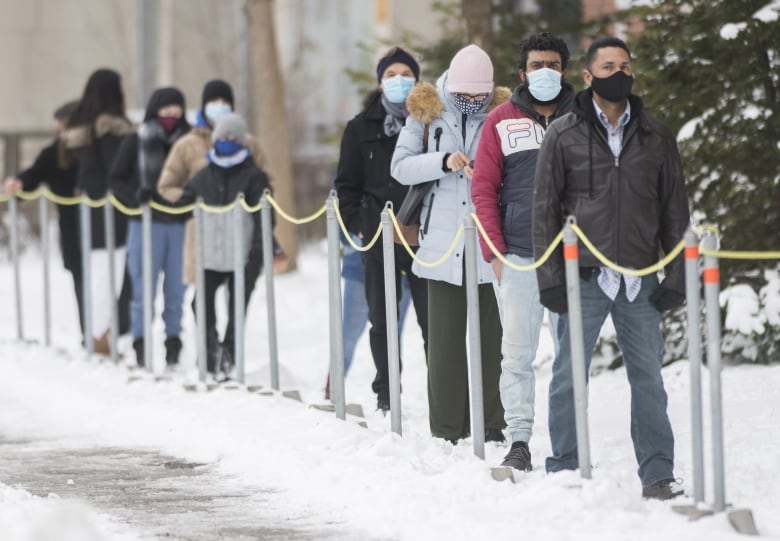More racially diverse areas reported much higher numbers of COVID-19 deaths: StatsCan
The most racially diverse neighbourhoods in Canada reported COVID-19 mortality rates more than twice as high as those reported by districts that are overwhelmingly white, according to new data released Wednesday by Statistics Canada.
The report, titled Year in Review, lays bare the uneven effects of this pandemic on Canadians of different racial backgrounds.
The data affirms what some Canadians have reported anecdotally for months: Black people in particular have been far more likely to succumb to the virus than members of other groups.
In areas where a quarter of the population or more identified as “visible minorities” — the term the government uses for non-white and non-Indigenous people — the mortality rate averaged 35 deaths per 100,000 people, compared to an average of 16 deaths per 100,000 people in regions where less than one per cent of the population was composed of racial minorities.
The data account for deaths between January 2020 and January 2021.
Women from areas where racial minorities are most prevalent reported mortality rates nearly three times higher than women from predominantly white areas — the places where just between one and 10 per cent of the population was made up of people of colour.

In B.C. and Quebec, the racial contrasts were particularly stark. Despite having much lower mortality rates than most of the country, B.C. posted 10 times more deaths in diverse areas (5.6 deaths per 100,000 population) than in places that were virtually all white (0.5 deaths per 100,000 population).
Racially diverse areas of Quebec experienced many more COVID-19-related deaths than nearly all-white census districts (123 per 100,000 versus 35.1 per 100,000). In Montreal, the mortality rate was 149.3 deaths per 100,000 in areas with the highest percentages of Black Canadians, compared with 88.1 per 100,000 in areas with the lowest percentages.
The data include one particularly alarming statistic for public health officials: Black Canadians, the people who have been hardest hit by the pandemic, are also the group most likely to say they are reluctant to take a COVID-19 vaccine.
Vaccine hesitancy rates higher among Black people
Based on data collected in September 2020, at a time when comparatively little was known about the prospects of a COVID-19 vaccine, 77 per cent of Black respondents to a StatsCan survey said they were “not very likely to take a vaccine” — a rate nearly 20 points higher than similar responses from white, Chinese and South Asian populations.
People with a high school education or less also reported higher rates of vaccine hesitancy: 64 per cent of them told StatsCan they were not likely to get the shot when it’s made available, which is double the rate reported in people with higher levels of formal education.
Members of racial minorities are also reporting higher unemployment rates and higher levels of financial stress because they’re more likely to work in low-wage jobs that can’t be performed remotely, StatsCan reported.
Twelve per cent of visible minority members reported being out of work as of January 2020, compared to 9 per cent of white Canadians. StatsCan found that Black Canadians and Canadians of Arab, southeast Asian, Latin American and Filipino extraction were more much more likely to report finding it “difficult” or “very difficult” to meet basic financial commitments over the past month.
Mental health-related police calls spike
The national statistics agency also has published new figures that quantify the mental health impact of this pandemic and the resulting public health measures that have kept family and friends apart.
StatsCan found that calls to police for mental health-related concerns have spiked at a time of severe disruptions to social and economic life.
Compared with 2019, the number of calls for service increased by 8 per cent during the first eight months of the pandemic. Substantial increases were seen in wellness checks (up 13 per cent), mental health-related calls such as a person in emotional crisis (up 12 per cent) and reports of domestic disturbances (up 8 per cent).
There were also notable drops in the frequency of certain crimes between March and October 2020. Shoplifting incidents declined 47 per cent, breaking-and-entering cases dropped 27 per cent and sexual assaults have declined 20 per cent since last year — all of which likely reflects social distancing efforts that kept shops closed and people at home.
The agency found that the mental health of Canadians improved in the fall with the return of school and as some public health restrictions were eased, only to deteriorate again in November and December as lockdowns were implemented in some jurisdictions.
‘Surge’ in cancer cases expected: StatsCan
As has been previously reported, the number of opioid-related overdoses has increased dramatically nationwide over the last year, but there are other physical health consequences of COVID-19.
Because a number of elective procedures and screening appointments have been cancelled or postponed, the statistics agency said Canada should brace for a spike in cancer diagnoses.
A cancer simulation model, OncoSim, shows a “surge” of projected cancer cases when screening resumes, the agency said.
A six-month suspension of screening for colorectal cancers could lead to an increase in the cancer incidence rate by 2,200 cases, with 960 more cancer deaths.
For breast cancer screening, a three-month interruption could also increase the number of cases diagnosed at advanced stages and cancer deaths over the next ten years, StatsCan said.



